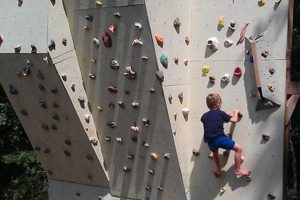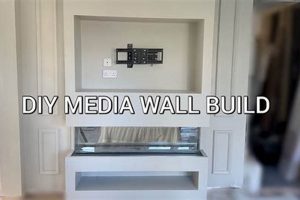A self-assembled, space-saving workstation affixed to a vertical surface, often a wall, provides a customizable alternative to traditional freestanding furniture. These installations can range from simple, foldable surfaces to more complex units incorporating shelving and storage, tailored to individual needs and available space.
The popularity of creating personalized workspaces has increased alongside trends in minimalist living and the desire for efficient home offices. This approach offers significant advantages, including adaptability to small areas, cost-effectiveness compared to commercially produced desks, and the opportunity for creative expression through individualized design and material choices. Historically, compact furniture solutions have addressed the needs of densely populated urban environments, and this approach represents a modern evolution of that principle.
The following sections will explore various design considerations, material selection guidelines, and construction techniques relevant to the successful implementation of these customized work surfaces.
Construction Considerations for Space-Optimized Work Surfaces
Achieving a functional and aesthetically pleasing workspace requires careful planning and execution. The following tips provide guidance on critical aspects of design and construction.
Tip 1: Structural Integrity: Prioritize secure wall mounting. Employ appropriate anchors and fasteners suitable for the wall type and anticipated weight load. Consult load-bearing guidelines for optimal support.
Tip 2: Ergonomic Height Assessment: Determine the optimal work surface height based on individual user dimensions. Incorrect height can lead to discomfort and long-term musculoskeletal issues. Standard ergonomic guidelines recommend adjusting height to allow for a 90-degree elbow angle when seated.
Tip 3: Material Selection Based on Durability: Choose materials resistant to wear and tear, suitable for the intended use. Solid wood, high-density particleboard, or laminate surfaces offer varying degrees of durability and aesthetic appeal.
Tip 4: Cable Management Integration: Incorporate cable management solutions during construction. Channels, grommets, or concealed compartments prevent cable clutter and maintain a clean workspace.
Tip 5: Space Optimization Through Foldable Designs: Consider a folding design for areas with limited space. Hinged surfaces that can be collapsed when not in use maximize floor space and improve room versatility.
Tip 6: Incorporating Storage Solutions: Maximize utility by integrating shelving or drawers. These storage elements should be designed to complement the desk’s overall aesthetic and functional requirements.
Tip 7: Design for Future Adaptability: Plan for potential changes in technology or work habits. Modular designs or easily adjustable components allow for future customization and extended usability.
Implementing these considerations will result in a durable, ergonomic, and space-efficient workstation. The subsequent sections will address aesthetic design choices and finishing techniques.
1. Structural Load Capacity
The viability of any self-assembled, wall-mounted workstation is intrinsically linked to its structural load capacity. This refers to the maximum weight the unit can safely support without risk of failure, including both the weight of the desk itself and any items placed upon it. Insufficient load capacity can lead to catastrophic collapse, potentially damaging property and causing injury. Therefore, accurate assessment and appropriate engineering are paramount. For instance, a desktop intended for a lightweight laptop requires substantially less robust support than one housing a desktop computer, monitor, and associated peripherals. Failure to account for these differences introduces significant safety risks.
Calculating the required load capacity involves several factors. First, the weight of the desktop material, whether solid wood, particleboard, or metal, must be considered. Second, the weight of all anticipated equipment, including computers, books, and accessories, must be added. Third, a safety margin should be incorporated to account for unexpected loads or dynamic forces. Wall type also influences structural capacity. Drywall, for example, necessitates specialized anchors capable of distributing weight across a larger surface area, unlike concrete or brick, which offer inherently greater resistance. A case study of a failed project involved inadequate drywall anchors supporting a particleboard desk laden with heavy textbooks, resulting in a complete detachment from the wall.
In conclusion, understanding and meticulously accounting for structural load capacity is non-negotiable for successful and safe implementation of a self-assembled workstation. Neglecting this aspect compromises the integrity of the entire project and jeopardizes user safety. By prioritizing accurate weight estimations, selecting appropriate mounting hardware, and considering wall type, the workstation can provide a reliable and functional workspace.
2. Ergonomic Height Optimization
Ergonomic height optimization represents a crucial element in the design and implementation of a self-assembled, wall-mounted workstation. The inherent adjustability of traditional desks is often absent in these fixed installations, making precise height determination paramount. Failure to optimize the work surface height can lead to musculoskeletal discomfort, reduced productivity, and potentially, long-term health issues. The direct correlation between workstation height and user well-being necessitates a meticulous approach during the planning and construction phase. A practical example involves an individual experiencing chronic neck pain due to a workstation positioned too low, forcing a forward head posture. Correcting the height alleviated the discomfort and improved posture. Therefore, the optimization of work surface height is not merely a design consideration but a preventative measure against potential health complications.
The process of ergonomic height optimization involves measuring the user’s seated elbow height. Ideally, the work surface should be positioned at or slightly below this measurement, allowing the forearms to rest comfortably on the desk with the elbows at a 90-degree angle. This posture minimizes strain on the shoulders, neck, and wrists. If the station is intended for use by multiple individuals, a compromise height must be determined, or a system for adjusting the chair height should be implemented. Another application involves considering the intended use of the desk. A drawing table, for example, may require a different height than a station used primarily for keyboarding. Proper placement of monitors, keyboards, and other peripherals further contributes to an ergonomic setup.
In conclusion, ergonomic height optimization is an indispensable consideration when constructing a self-assembled, wall-mounted workstation. Ignoring this aspect can negate the benefits of creating a custom workspace and potentially lead to adverse health outcomes. While achieving perfect ergonomic alignment may present challenges, adherence to established guidelines and careful attention to individual user needs will significantly enhance the functionality and comfort of the work surface. Therefore, meticulous planning is the key to achieving a healthy and productive workspace.
3. Space-Saving Foldability
Space-saving foldability constitutes a critical design consideration for the successful implementation of a self-assembled, wall-mounted workstation, particularly in environments with limited square footage. The capacity to collapse the work surface when not in use significantly enhances the utility and adaptability of the space, transforming a dedicated work area into a multi-functional environment. This aspect elevates the appeal of a wall-mounted solution over traditional, static desks, particularly in apartments, small homes, or shared living spaces.
- Hinge Mechanisms and Load Distribution
The selection and implementation of appropriate hinge mechanisms are paramount for achieving reliable and safe foldability. Heavy-duty hinges designed for significant load-bearing capacity are essential to support the weight of the desk surface and any associated equipment. Poorly chosen hinges can result in instability, premature failure, and potential injury. A well-engineered system ensures even weight distribution across the hinges, minimizing stress and maximizing the lifespan of the structure. For example, using piano hinges spanning the entire width of the desk offers greater stability compared to relying on individual, smaller hinges.
- Locking Mechanisms for Secure Deployment
Beyond the foldability aspect, securing the desk in its deployed position is equally crucial. A reliable locking mechanism prevents accidental collapse during use, providing a stable and safe work surface. Various locking systems, such as folding brackets, latches, or slide bolts, can be implemented depending on the desk design and aesthetic preferences. The chosen mechanism should be easily operable and visually unobtrusive when the desk is in use. An example of a secure locking mechanism is a heavy-duty folding bracket that automatically locks into place when the desk is raised, requiring deliberate action to release it.
- Material Selection and Weight Considerations
The choice of materials directly influences the weight of the folding desk and, consequently, the ease of operation and the demands placed on the supporting wall structure. Lightweight materials, such as plywood or medium-density fiberboard (MDF), are often preferred to minimize strain on the hinges and wall mounting hardware. However, the chosen materials must also possess sufficient strength and durability to withstand daily use. Balancing weight considerations with structural integrity is essential for a successful folding station. Employing a lightweight frame combined with a durable laminate surface represents a practical compromise.
- Aesthetic Integration and Concealment
Foldability also presents opportunities for aesthetic integration and concealment when the desk is not in use. The design can be tailored to seamlessly blend with the surrounding decor, effectively disappearing into the wall when folded away. This can be achieved through the use of matching paint colors, concealed hinges, and minimalist design. The ability to transform the desk into a discreet, wall-mounted element significantly enhances its appeal in aesthetically conscious environments. Implementing a cabinet-style enclosure for the desk when folded allows it to function as a decorative element or storage unit.
In summary, space-saving foldability provides a significant advantage for self-assembled, wall-mounted workstations, particularly in space-constrained environments. When executed effectively, the folding mechanism transforms a dedicated workspace into a versatile, multi-functional area, further enhancing the appeal and practicality of the system. Balancing structural requirements, operational ease, and aesthetic integration is vital for a successful and well-received design.
4. Integrated Storage Solutions
The incorporation of integrated storage solutions within a self-assembled, wall-mounted workstation is a strategic design consideration that significantly enhances the functionality and organizational capacity of the workspace. These solutions provide dedicated spaces for storing essential items, reducing clutter and promoting a more efficient and focused work environment.
- Shelving for Accessibility
Shelving units integrated into the desk structure offer readily accessible storage for frequently used items such as books, stationery, or reference materials. The proximity of these shelves allows users to retrieve and return items without disrupting their workflow. A well-designed shelving system maximizes vertical space utilization, effectively expanding storage capacity without increasing the desk’s footprint. For example, adjustable shelves can accommodate items of varying heights, providing flexibility and adaptability.
- Drawers for Concealed Organization
Drawers provide a discreet storage option for items that require concealment, such as personal belongings, sensitive documents, or electronic accessories. The inclusion of drawers contributes to a cleaner and more organized aesthetic by keeping these items out of sight. Drawers can be customized with dividers or organizers to further enhance their functionality and prevent clutter. An effective drawer system employs smooth-gliding mechanisms for easy access and durable construction to withstand frequent use.
- Cable Management Systems
Effective cable management is an essential aspect of integrated storage solutions, preventing tangled wires and promoting a safer and more aesthetically pleasing workspace. Cable management systems can include channels, grommets, or concealed compartments that route and organize cables from electronic devices. This not only minimizes visual clutter but also reduces the risk of accidental disconnections or damage to cables. A practical example is the integration of a cable tray beneath the desk surface to conceal power cords and data cables.
- Fold-Down or Hidden Compartments
Fold-down or hidden compartments offer a unique and space-saving storage solution, particularly in workstations with limited dimensions. These compartments can be used to store infrequently used items or to provide a temporary storage space for items that need to be quickly stowed away. The concealed nature of these compartments contributes to a clean and uncluttered aesthetic. A fold-down compartment could house a keyboard or laptop, which can be easily accessed and then concealed when not in use.
These integrated storage solutions, when thoughtfully implemented, elevate the functionality and practicality of a self-assembled, wall-mounted workstation, transforming it from a simple work surface into a comprehensive and organized workspace. The strategic incorporation of shelving, drawers, cable management, and hidden compartments provides ample storage capacity while maintaining a clean and efficient environment.
5. Aesthetic Customization
Aesthetic customization in the context of a self-assembled, wall-mounted workstation transcends mere decorative choices. It represents a deliberate integration of the workstation’s design with the existing architectural and stylistic elements of the surrounding environment, thereby enhancing the overall harmony and visual appeal of the space.
- Material Selection and Finish
The choice of materials and their corresponding finishes directly influences the workstation’s aesthetic impact. Solid wood, laminate, metal, and composite materials each offer distinct visual qualities and tactile experiences. Furthermore, the application of paints, stains, veneers, or edge banding contributes to the final aesthetic outcome. For instance, a workstation constructed from reclaimed wood with a natural oil finish can evoke a rustic aesthetic, while a sleek, white laminate surface paired with brushed aluminum hardware aligns with a modern design sensibility. The selection must complement existing furniture and architectural details.
- Color Palette and Contrast
The strategic use of color plays a significant role in creating visual interest and defining the workstation’s presence within the room. The selection of colors should consider the existing color palette of the space, as well as the desired mood and atmosphere. High-contrast color schemes can create a focal point, while monochromatic palettes can promote a sense of calm and cohesion. The incorporation of accent colors can add visual dynamism and personalize the workstation’s appearance. Consider a muted gray workstation with pops of vibrant color on shelving units to create contrast without overwhelming the space.
- Hardware and Accessories
The selection of hardware, such as drawer pulls, hinges, and mounting brackets, contributes significantly to the workstation’s overall aesthetic. These elements can be chosen to complement or contrast with the main surface material, adding visual interest and reinforcing the desired design style. Similarly, the integration of accessories, such as task lighting, monitor arms, and cable management solutions, should be considered from an aesthetic perspective. For example, sleek, minimalist task lighting can enhance the workstation’s modern aesthetic, while ornate, vintage-inspired hardware can complement a more traditional design scheme.
- Form and Proportion
The overall form and proportions of the workstation are critical in determining its visual impact. The dimensions, shape, and arrangement of the desk surface, shelving units, and other components should be carefully considered to create a balanced and harmonious composition. A workstation with clean lines and simple geometric forms can convey a sense of modernity, while a more elaborate design with curved edges and asymmetrical elements can evoke a more organic or whimsical aesthetic. The proportion of the workstation relative to the surrounding space should also be considered to ensure it does not overwhelm or underwhelm the room.
These facets of aesthetic customization are integral to the creation of a self-assembled, wall-mounted workstation that not only fulfills its functional purpose but also enhances the visual appeal and overall ambiance of the surrounding environment. By carefully considering material selection, color palette, hardware, and form, individuals can create a personalized workspace that reflects their individual style and complements their existing decor.
Frequently Asked Questions
The following addresses common inquiries regarding the design, construction, and implementation of customized work surfaces, providing clarification on key aspects of the process.
Question 1: What are the primary considerations when determining the appropriate weight capacity for a self-assembled wall-mounted workstation?
Calculating weight capacity necessitates accounting for the desktop material’s mass, the collective weight of all intended equipment (computers, books, peripherals), and a safety margin to accommodate unexpected loads or dynamic forces. Wall type significantly influences anchor selection and weight distribution strategies.
Question 2: How does ergonomic height optimization contribute to the long-term health and well-being of users?
Precise height determination minimizes musculoskeletal strain by promoting a neutral posture, reducing the risk of discomfort and potential long-term health issues. Maintaining a 90-degree elbow angle when seated is a critical ergonomic consideration.
Question 3: What are the key benefits of incorporating space-saving foldability into the design of a wall-mounted workstation?
Foldability maximizes floor space by allowing the workstation to be collapsed when not in use, transforming a dedicated work area into a multi-functional environment. This feature is particularly advantageous in space-constrained living environments.
Question 4: What types of integrated storage solutions are most effective for optimizing organization and reducing clutter?
Effective storage solutions encompass shelving for readily accessible items, drawers for concealed storage, cable management systems to prevent tangled wires, and fold-down compartments for infrequently used items. Strategic integration of these elements promotes a clean and efficient workspace.
Question 5: How does aesthetic customization contribute to the overall appeal and functionality of a self-assembled workstation?
Aesthetic customization allows for seamless integration with the existing environment, enhancing the overall harmony and visual appeal of the space. Careful selection of materials, colors, hardware, and form ensures the workstation complements the existing decor and reflects individual style preferences.
Question 6: What are the primary safety precautions to observe during the construction and installation of a self-assembled wall-mounted workstation?
Safety precautions include utilizing appropriate wall anchors and fasteners suitable for the wall type and anticipated weight load, ensuring secure mounting, verifying the structural integrity of all components, and consulting load-bearing guidelines for optimal support. Prioritizing safety during construction mitigates the risk of accidents or structural failure.
The preceding questions and answers provide a comprehensive overview of critical aspects related to creating a self-assembled workstation. Careful consideration of these factors ensures the creation of a functional, ergonomic, and aesthetically pleasing workspace.
The following section will delve into advanced design strategies and innovative construction techniques.
Conclusion
The preceding analysis has explored critical design, construction, and implementation aspects of the self-assembled, wall-mounted workstation. Structural load capacity, ergonomic considerations, space-saving foldability, integrated storage solutions, and aesthetic customization emerged as essential elements for creating a functional and efficient workspace. Each aspect contributes uniquely to the overall utility and longevity of the installation.
The principles outlined herein provide a framework for informed decision-making in the creation of a customized workspace solution. Future endeavors in this area should focus on innovative materials and construction techniques to further enhance the practicality, sustainability, and adaptability of this increasingly relevant alternative to traditional furniture. Thorough planning and precise execution remain paramount for realizing the full potential of this approach.







